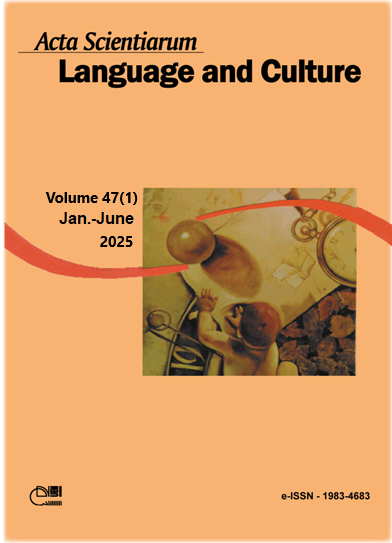Comparative analysis of the rhetorical structure of argumentative answer texts produced by entrance exam candidates and by ChatGPT
Abstract
Large computational language models, such as ChatGPT, have demonstrated a high capacity to process and generate texts with a high degree of communicative coherence, making their application possible in the most different areas of knowledge. Given this new field to be explored, in this work, we intend to compare the rhetorical structure of fifteen texts of the argumentative answer genre produced by candidates for the entrance exam at the State University of Maringá with the rhetorical structure of fifteen texts of the same genre produced by ChatGPT from the same instructions and the same supporting texts. The theoretical-methodological apparatus used is the Rhetorical Structure Theory, a descriptive theory that studies text organization by means of the implicit relations that are held between parts of the text. Regarding the results, it was found that ChatGPT used two answer strategies. In the first, the AI partially takes up the question and answers that the secret of the entrance exam is a combination of three factors (intelligence, effort and luck). The other strategy is to start the text by answering that intelligence is the main factor. This proposition is briefly elaborated and then the AI establishes a contrasting relationship stating that effort is equally important. In this way, the text does not have just one central unit, but two. In the texts produced by candidates for the entrance exam, in addition to the elaboration relation, evidence and justification relations were also found, which aim to increase the reader's belief in the thesis defended by the author. In another analysis parameter, a high frequency of repetition of nouns and adjectives was observed in the central unit of the texts generated by ChatGPT in comparison with the texts produced by entrance exam candidates, who used a wider repertoire of words.
Downloads
References
Antonio, J. D. (2015). Detecting central units in argumentative answer genre: signals that influence annotators’ agreement [Apresentação de trabalho]. 5th Workshop “RST and Discourse Studies”. Actas del 31º Congreso de la Sociedad Española del Procesamiento del Lenguaje Natural. Alicante, ES.
Antonio, J. D. & Santos, J. A. (2017). Resposta argumentativa. In J. D. Antonio, & P. Navarro (Orgs.), Gêneros textuais em contexto de vestibular (pp. 197-214). Eduem.
Carlson, L., & Marcu, D. (2001). Discourse tagging reference manual. University of Southern California.
Castilho, A. T. (2010). Nova gramática do português brasileiro. Contexto.
Iruskieta, M., Ilarraza, A. D., Labaka, G., & Lersundi, M. (2015). The detection of central units in Basque scientific abstracts [Apresentação de trabalho]. 5th Workshop “RST and Discourse Studies”. Actas del 31º Congreso de la Sociedad Española del Procesamiento del Lenguaje Natural. Alicante, ES.
Mann, W. C., & Thompson, S. A. (1988). Rhetorical Structure Theory: toward a functional theory of text organization. Text – Interdisciplinary Journal for the Study of Discourse, 8(3), 243-281. https://doi.org/10.1515/text.1.1988.8.3.243
Matthiessen, C. M. I. M., & Thompson, S. A. (1988). The structure of discourse and ‘subordination’. In J. Haiman, & S. A. Thompson (Eds.), Clause combining in grammar and discourse (pp. 275-330). John Benjamins.
Menegassi, R. J. (2010). Gêneros discursivos [Apostila-Mimeo].
Menegassi, R. J. (2011). A escrita na formação docente inicial: influências da iniciação à pesquisa. Signum: Estudos da Linguagem, 14(1), 387-419. https://doi.org/10.5433/2237-4876.2011v14n1p387
Neves, M. H. M. (2000). Gramática de usos do português. Unesp.
Resolução nº 005/2023-CEP, de 13 de abril de 2023. (2023, 13 de abril). Aprova o Regulamento do concurso vestibular para Ingresso nos Cursos de Graduação da UEM, alterada pela Resolução n.º 008/2023-CEP, publicada em 15 de maio de 2023. Universidade Estadual de Maringá. http://www.scs.uem.br/
Zeldes, A. (2016). rstWeb - A Browser-based Annotation Interface for Rhetorical Structure Theory and Discourse Relations [Apresentação de trabalho]. Proceedings of NAACL-HLT 2016. San Diego.
DECLARATION OF ORIGINALITY AND COPYRIGHTS
I Declare that current article is original and has not been submitted for publication, in part or in whole, to any other national or international journal.
The copyrights belong exclusively to the authors. Published content is licensed under Creative Commons Attribution 4.0 (CC BY 4.0) guidelines, which allows sharing (copy and distribution of the material in any medium or format) and adaptation (remix, transform, and build upon the material) for any purpose, even commercially, under the terms of attribution.
Read this link for further information on how to use CC BY 4.0 properly.




















6.png)









